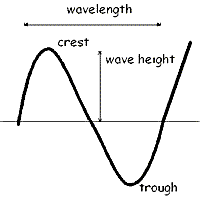BACKGROUND:
Visible light is only a small
part of the entire electromagnetic wave spectrum, as shown in
the diagram below. In nature, waves differ in frequency and wavelength,
however all have the same speed (186,000 miles per second or
approximately 300,000 kilometers per second).
PROCEDURE:
 Illustrate the parts of a
wave in
the electromagnetic spectrum. An electric field radiates from every
substance in the form of these waves. Wavelength refers to the distance
between crest to crest; frequency refers to the number of times the wave
cycles in a given time. The shorter the wavelength, the higher the
frequency. The longer the wavelength, the lower the frequency. The waves
of the spectrum reflect the difference in frequency. Illustrate the parts of a
wave in
the electromagnetic spectrum. An electric field radiates from every
substance in the form of these waves. Wavelength refers to the distance
between crest to crest; frequency refers to the number of times the wave
cycles in a given time. The shorter the wavelength, the higher the
frequency. The longer the wavelength, the lower the frequency. The waves
of the spectrum reflect the difference in frequency.
- Using the material in the module,
give a group of students a flashlight and one prism, quartz, mirror,
cube magnifier, convex lens, ulexite, and calcite. Students should shine
the light through the items to see what the light does. Have them draw a
picture of what they see. The room must be dark in order for the
students to observe the phenomena. Repeat the activity with a laser and
compare the differences. The laser light is sharper than light from the
flashlight. In an upcoming lab, students will look at a laser in more
detail. Have students become familiar with the laser and go over the
instructions for safety. LASERS ARE NOT TOYS!
- Conclude that light can be
modified by different mediums. Convex lenses will concentrate the light,
mirrors will reflect the light. The flashlight will make the quartz
shine, but the laser will almost irradiate it. When shown through
calcite, the laser will double the light, however the flashlight will
not produce any doubling. The laser light will go through the ulexite,
but the flashlight will not. This may vary some with the materials and
the light source you use. Students will learn more about the laser in
the post lab. This lab serves to illustrate that there is a difference
between laser light and flashlight light.
- The answers are dependant on the
individual specimens. The key objective is to observe laser and
incoherent light.
|